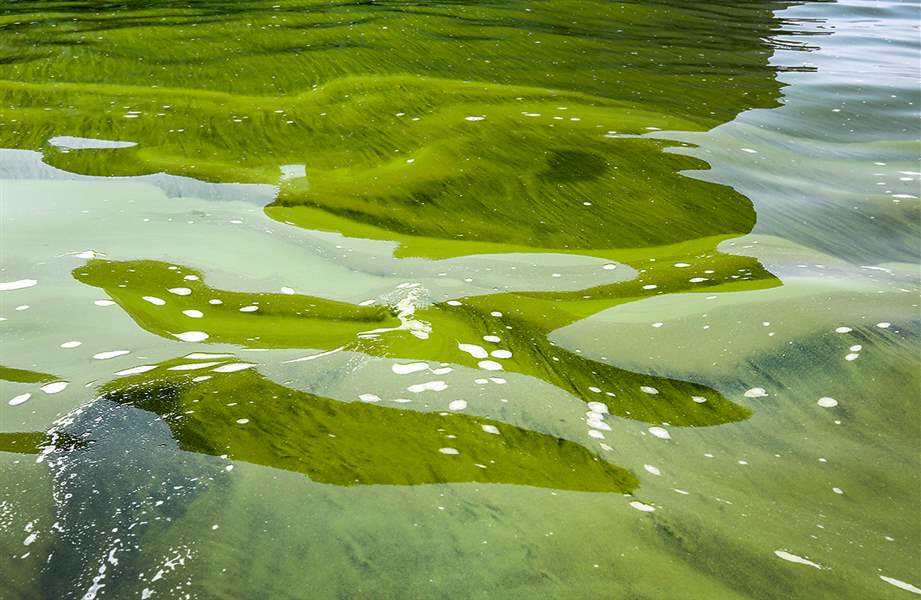
Fish must adapt
Walleye, perch patterns shift with algae
8/5/2014
Algae is visible in Lake Erie near the Toledo water intake crib Sunday. Algae’s presence could help account for walleye staying closer to the shore and perch fleeing for deeper waters.
THE BLADE/DAVE ZAPOTOSKY
Buy This Image

Fishermen will go where the fish are. Stash that one in the file of certainties and profundities, right next to the words on death and taxes combo.
Massive blooms of algae, some of which spawn the toxin microcystin that contaminated the drinking water for hundreds of thousands of residents of northwest Ohio and southeast Michigan over the weekend, have complicated the picture for Lake Erie anglers in their pursuit of fish.
But the lake’s walleye and yellow perch — the primary targets of a majority of fishermen — have not skedaddled in search of distant, pristine waters. Quite the contrary, for the walleyes.
Paul Pacholski, president of the Lake Erie Charter Boat Association, said the Lake Erie walleyes have simply adjusted their movement patterns and apparently made use of some of the large expanses of algae floating on the surface. With eyes that are hyper-sensitive to light and allow them to see their prey in very low-light conditions, these fish appear to be finding the environment under the mats of algae advantageous.
“The walleye don’t seem to care about the presence of the algae on the surface — they feed under it,” Pacholski said. “Lots of guys will target the algae for walleyes for that reason.”
Jeff Tyson, the Lake Erie program administrator for the Ohio Division of Wildlife’s fisheries unit in Sandusky, said the scientific database on how harmful algal blooms (HABs) impact the patterns of fish is thin at this point.
“We don’t know a great deal about how these HABs affect the behavior and distribution of fish,” Tyson said. “We have heard folks say that they are finding walleye feeding under the matting of algae, but that’s just anecdotal information at this point.”
Justin Chaffin, the senior researcher for the Ohio Sea Grant at Stone Lab, the Ohio State University facility on Gibraltar Island in Put-in-Bay, said he suspects that walleyes will feed under areas where the algae is congealed on the surface.

Algae is visible in Lake Erie near the Toledo water intake crib Sunday. Algae’s presence could help account for walleye staying closer to the shore and perch fleeing for deeper waters.
“We’re still working to figure this out, but what we know from laboratory results is that fish such as walleye, trout, and salmon that prefer cooler, clearer water don’t like to be around these blooms because they are irritating to the gills,” he said. “If they are catching fish there, that probably means that the algae is just a surface scum, and the walleye are below it and not in direct contact with the algae. If the wind breaks it up, it will probably be more of an issue for the walleye.
Chaffin said species such catfish, carp, and freshwater drum (sheepshead) are likely much more tolerable of the algae.
Pro angler and guide Chris Morris said his experiences this summer tell him that the presence of significant amounts of algae has likely altered the normal movement patters of Lake Erie walleye and yellow perch.
“We’re catching a lot of walleye closer to shore right now, in 20 feet of water and under, when we would expect them to be out deeper at this point in the year,” he said. “The algae is not a good thing at all, but it’s just created a unique situation where the baitfish go there, and the big fish follow.”
Morris said steady walleye catches have come from an area roughly inside a triangle from the Toledo water intake to “A” can of the firing range and then to Crane Creek.
“The fish have been in there,” he said. “I believe they are taking the low-light conditions, due to the algae, and using it to their advantage. Anywhere near the shore in this end of the lake you find all this green slime — just as green as it can be.”
Morris said yellow perch are currently being found in deeper water than at this time during the last few years. Pacholski said the perch have migrated away from the significant patches of algae.
“The yellow perch don’t like it at all,” he said. “They need a higher level of light to feed, and they don’t seem to want anything to do with the algae.”
Captain Bob Brown, Jr., who operates Channel Grove Marina in Marblehead, said he has concentrated his most recent charter outings in the waters to the north and east of the Lake Erie Islands complex, and he’s encountered very little algae.
“Out around the eastern islands, Pelee and Kelleys, there’s not much algae there,” he said. “And off Catawba and Marblehead and around East Harbor State Park, we just don’t seem to have a lot of it. We’re fishing wherever we want right now.”
Brown said he has taken parties into Canadian waters recently and found the areas east of Pelee Island to contain “beautiful, clear water.” He did encounter some algae north of Pelee, which Brown theorized was likely produced by outflow from the Detroit River, which sometimes carries improperly treated sewage.
Chaffin said that just as we seek more information to combat, control and curtail the harmful algal blooms, we find out how little we really know about the impact these blooms might have on the lake’s fishes.
“All the work is done in laboratories,” he said. “We can track the movement of the bloom, but tracking fish is a lot harder, since they move around so fast.”
Contact Blade outdoors editor Matt Markey at: mmarkey@theblade.com or 419-724-6068.